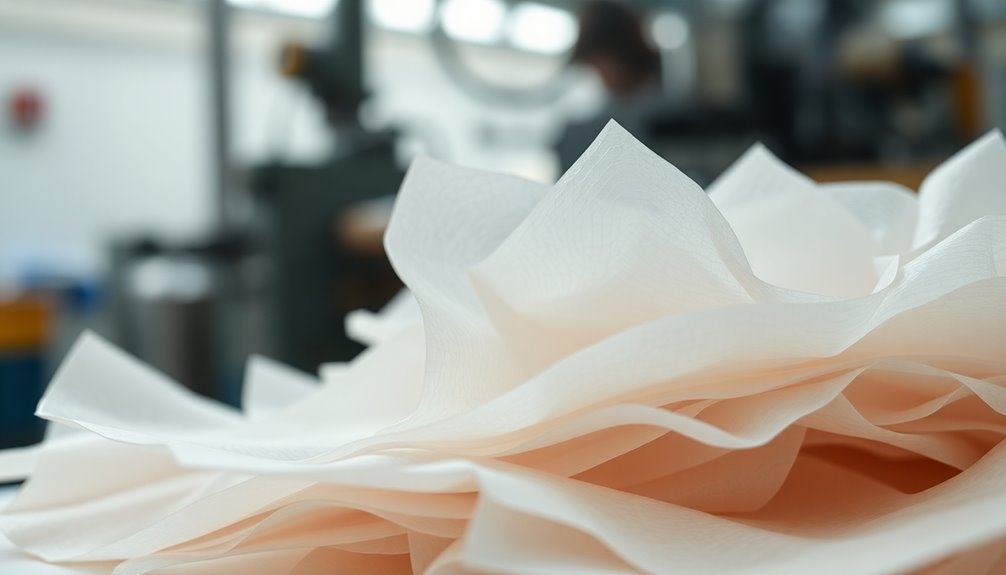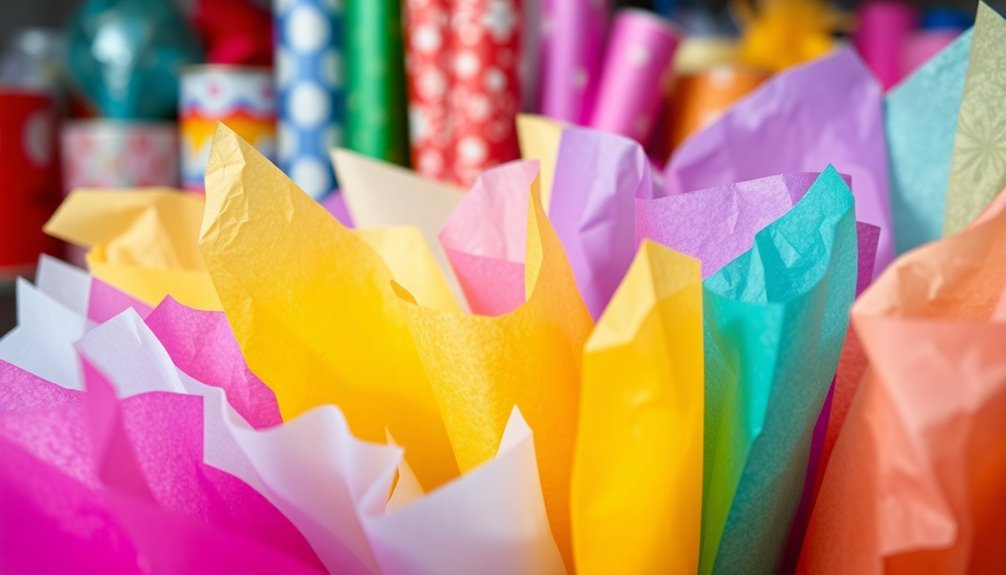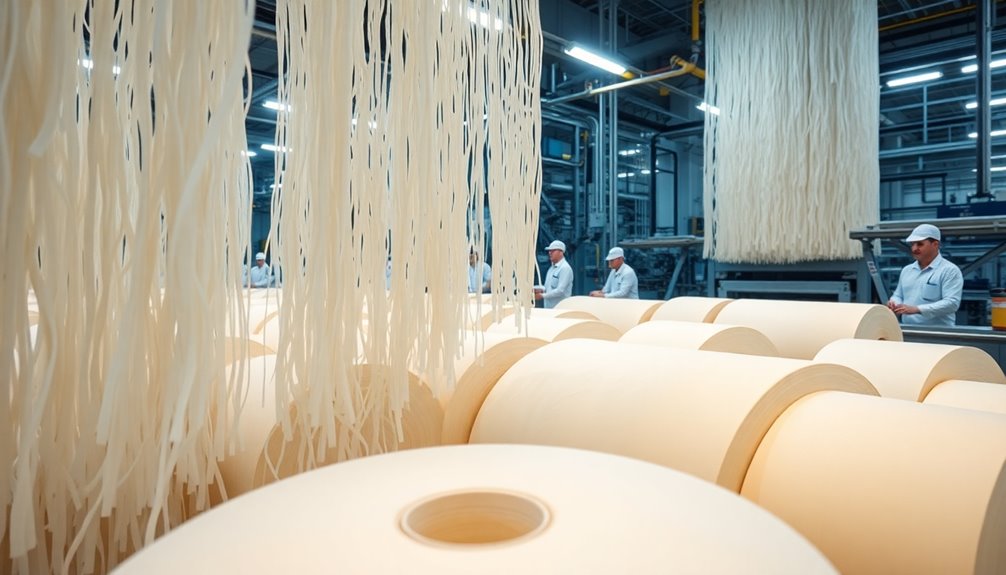Tissue paper is a lightweight and versatile material used mainly for wrapping and protecting delicate items. It's made from recycled paper pulp or virgin wood fibers, making it an eco-friendly choice. Unlike facial or toilet tissue, it's thinner and comes in various colors and textures, perfect for arts and crafts or gift-wrapping. Its thickness varies between 10 to 35 grams per square meter, ensuring it's softer and more absorbent than regular paper. If you're curious about its manufacturing process or the different types available, there's a lot more to discover.
Key Takeaways
- Tissue paper is a delicate, versatile product primarily used for wrapping and protecting fragile items.
- It is made from recycled paper pulp or virgin wood fibers, making it an eco-friendly option.
- Tissue paper differs from facial tissues and toilet tissue, which serve personal hygiene purposes.
- Available in various colors and finishes, it is popular in arts and crafts for decorative uses.
- The manufacturing process involves shaping wet pulp into sheets, drying, and creping for enhanced softness and absorbency.
Definition of Tissue Paper

Tissue paper embodies versatility and delicacy, making it a staple in both everyday and creative applications. This thin paper used for wrapping and protecting delicate items showcases breathable qualities, ensuring your treasures remain safe while adding an elegant touch.
Typically made from recycled paper pulp or virgin wood fibers, tissue paper offers an eco-friendly option for various uses.
It's important to note that tissue paper differs from other types of tissue, like facial tissues and toilet tissue. While those are designed for personal hygiene and possess higher absorbency levels, tissue paper is lightweight and less absorbent, making it unsuitable for those purposes.
When you consider the thickness, tissue paper usually ranges from 10 to 35 grams per square meter (GSM), which is markedly lighter than standard printer paper.
This lightweight paper comes in a variety of colors and finishes, rendering it popular for decorative tasks in arts, crafts, and gift wrapping.
Manufacturing Process

Creating tissue paper involves a precise manufacturing process that starts with paper pulp derived from wood fibers, often incorporating recycled materials like cardboard and newspapers.
You'll find that the process begins with wet pulp being formed and rolled on a paper machine, achieving the desired thickness, which typically ranges from 10 to 35 grams per square meter (GSM).
- The pulp is shaped into sheets, ready for drying.
- Steam-heated sections remove moisture, solidifying the paper.
- Creping enhances the tissue's absorbency and softness.
During creping, controlled adhesive application and doctor blade geometry play essential roles. This step is critical to ensuring the final product is both soft and absorbent.
For those looking for high-quality tissue paper, the Through-Air-Dried (TAD) process is worth noting. While it consumes twice the energy of traditional methods, it greatly boosts absorbency, making it a preferred technique among manufacturers.
In essence, the manufacturing process of tissue paper is a blend of innovative technology and careful craftsmanship, transforming wood fibers and recycled products into the soft, absorbent sheets you rely on daily.
Types and Applications

There are several types of tissue paper, each tailored for specific applications that highlight its lightweight and breathable nature.
Wrapping tissue is one of the most common types, often used for gift wrapping, allowing you to present your gifts beautifully. If you need to protect delicate items, you might opt for acid-free tissue, which prevents damage during storage.
In personal care, facial tissues serve an essential hygiene purpose, making them indispensable for everyday use. You'll find toilet tissue specifically designed for sanitary use after restroom visits, providing comfort and cleanliness.
The versatility of tissue paper extends to decorative uses as well. You can choose from a wide range of colors and finishes, making it popular for arts and crafts projects, as well as floral arrangements.
As the demand for hygiene products rises, the global tissue market is expanding, with significant consumption in various paper products like paper towels and facial tissues.
Understanding these types and their applications helps you make informed choices for your needs, whether for personal care, gift-giving, or creative projects.
Environmental Considerations

When considering environmental impact, it's vital to recognize the consequences of tissue paper production on our planet. The production of tissue paper contributes considerably to deforestation, with a staggering 270,000 trees flushed down the toilet daily due to toilet paper usage.
However, there's hope in the form of sustainable practices and recycled paper, which can help mitigate some of these issues.
- The use of recovered fibers in manufacturing
- Eco-labeling initiatives promoting sustainable choices
- Life-cycle assessments revealing the trade-offs of fiber sources
About 46.5% of raw materials in the paper industry come from recovered fibers, helping reduce the environmental impact of new tree harvesting.
Additionally, sustainable practices aim for a 25% reduction in CO2 emissions, addressing climate change concerns. Programs like the German Blue Angel encourage the use of recovered fibers, making it easier for you to choose eco-friendly options.
While both new and recovered fibers have their pros and cons, responsible sourcing and production methods are vital to minimizing the environmental footprint of tissue paper used daily.
Market Trends and Innovations

As urbanization and rising disposable incomes reshape consumer habits, the tissue paper market is experiencing significant growth and innovation. Global tissue production is estimated at 21 million tonnes, with Europe contributing around 6 million tonnes and a market value of approximately 10 billion Euros, growing at about 3% annually.
In contrast, North America consumes nearly three times more tissue products than Europe, indicating major regional differences in demand.
The COVID-19 pandemic has also influenced market trends, driving increased demand for hygiene products and shifting away-from-home business dynamics. As consumers prioritize cleanliness, the tissue market is projected to grow by 8-9% in China and 2-3% in Europe.
Innovations play an essential role in this growth, focusing on enhancing product performance through improved absorbency and strength. Companies are investing in sustainable manufacturing practices, aligning their products with eco-friendly initiatives.
This commitment to sustainability not only meets consumer expectations but also supports broader environmental goals. As you navigate this evolving landscape, staying informed about these trends and innovations will help you make better choices in the tissue paper market.
Frequently Asked Questions
What Is the Difference Between Tissue Paper and Normal Paper?
When you compare tissue paper to normal paper, you'll notice key differences.
Tissue paper's thinner and more delicate, often used for wrapping or crafting, while normal paper's sturdier, suitable for printing.
You'll find tissue paper has a softer texture, making it ideal for personal care products, whereas normal paper can be rougher and less absorbent.
Fundamentally, tissue paper is designed for single-use or light applications, while normal paper withstands more handling.
What Is Tissue Paper Made Out Of?
Tissue paper's made primarily from paper pulp, which comes from wood fibers or recycled materials like cardboard and newspapers.
You'll find that its production involves rolling wet pulp on machines to create the right thickness and texture.
With a low basis weight of 10 to 35 grams per square meter, it's lighter than regular paper.
It's also dried in steam-heated sections before being rolled onto large cylinders, forming the final product you see.
Why Can't Tissue Paper Be Recycled?
You can't recycle tissue paper primarily because it's often contaminated with food, oils, or moisture, which disrupts the recycling process.
Its lightweight, low-quality fibers make it unsuitable for reprocessing into new products. Additionally, many recycling facilities aren't equipped to handle its high basis weight.
Since most municipalities don't accept it in curbside recycling, a lot of tissue paper ends up in landfills instead of being reused.
What Is the Difference Between Tissue Paper and Toilet Paper?
You might think tissue paper and toilet paper are similar, but they serve different purposes.
Tissue paper's thin and lightweight, perfect for wrapping gifts or crafting, while toilet paper's designed for personal hygiene. It's softer and more absorbent, making it suitable for delicate skin.
Tissue paper usually comes in various colors for decoration, whereas toilet paper is typically sold in rolls for single-use convenience.
Understanding these differences helps you choose the right product for your needs.
Conclusion
In conclusion, tissue paper is a versatile product that's essential in everyday life. Understanding its manufacturing process, types, and applications can help you appreciate its role in various settings, from personal use to industrial applications. As you consider environmental impacts, you might find it encouraging to see innovations aimed at sustainability. Staying informed about market trends guarantees you're making choices that align with both your needs and environmental responsibility, making tissue paper more than just a simple product.










